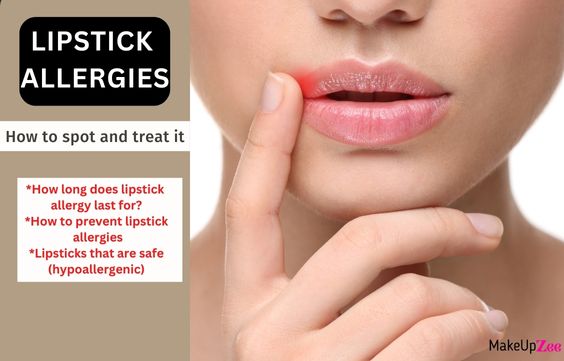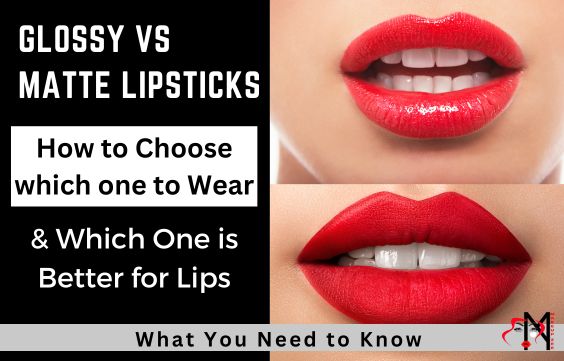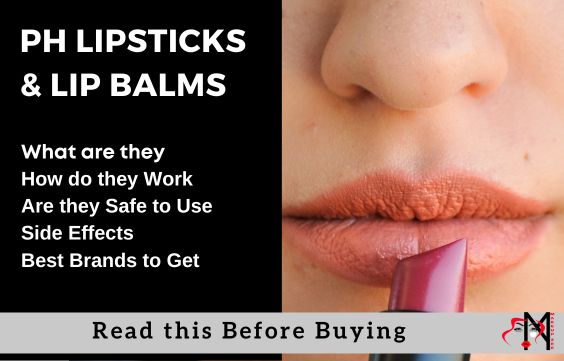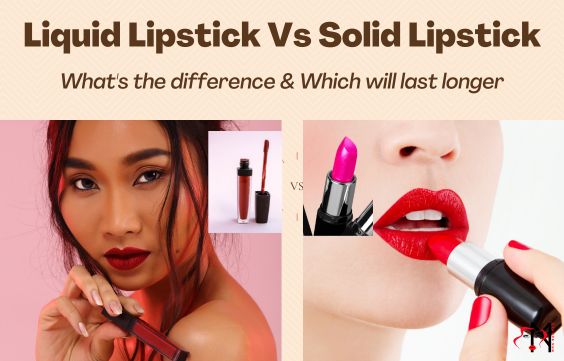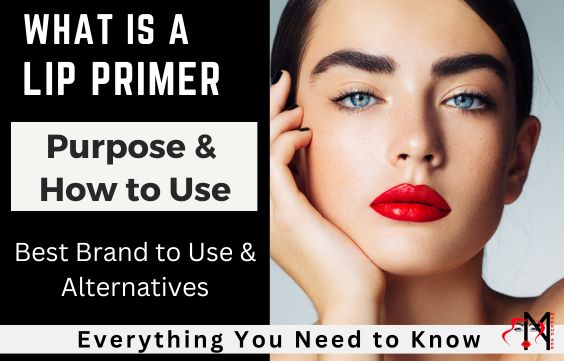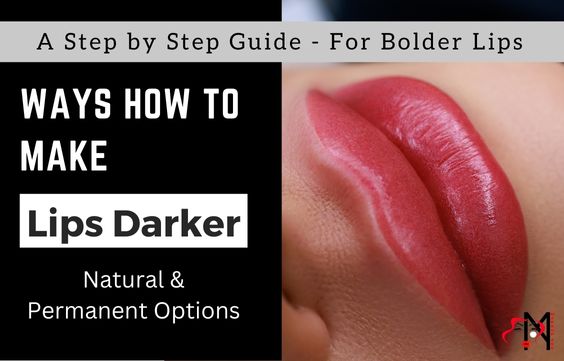Does Lipstick Darken Lips & Can it be Bad for Your Lips

Most people wear some form of lip color especially lipstick on their lips daily, especially when they are self-conscious about the color of their lips.
In this article, we have delved into the side effects of wearing lipsticks and whether they can cause your lips to darken or develop pigmentation.
We will also share with you;
- how to properly wear lipsticks to protect the lips
- And key ingredients to avoid when choosing a brand of lipstick.
Keep reading, for the answers to all these questions.
Can Lipsticks make your lips darker
If the lipstick is applied properly on the lips and does not disrupt the moisture barrier or cause no irritation, then it is unlikely to darken lips.
However, lipsticks can make your lips darker if they irritate your lips. Irritation from lipsticks can occur if you:
- Have an allergic reaction to an ingredient in the lipstick. Allergic reactions cause irritation, and this irritation leads to pigmentation.
- Use lipsticks that are very long-lasting, especially matte lipsticks. These types of lipsticks tend dry out the lips.
- Using very deep-colored lipsticks. These colors tend to stick to the outer layer of the lip skin and are more likely to cause pigmentation issues.
Related Article: Do Lipstick Expire & Is it Safe to use – Possible Dangers
1. How an allergy to lipsticks can darken Lips
Allergic contact cheilitis (ACC) is allergic contact dermatitis (ACD) that affects the lips. People may also use the term “lipstick cheilitis” to refer to ACC. This is because one of the main causes of ACC is an allergy to an ingredient in lipsticks.
ACC causes the lips to look inflamed and swollen and may cause patches of scaly skin to appear on the lips. On white skin, a person may notice redness.
On black skin, a person may notice the skin turning dark brown, purple, or reddish. The constant irritation can eventually lead to permanent hyperpigmentation or darkness of the lips.
To learn more about Lipstick allergies check out my article on Lipstick Allergies: How to Spot and Treat
2. How long-lasting Matte Lipsticks can cause Dark Lips
Another reason for hyperpigmentation on the lips is a lack of moisture. Long-lasting lipsticks especially matte lipsticks tend to be very drying.
So, if your lips are already dehydrated, and you constantly use long-wear lipsticks, they may get darker with time. A layer of dead cells would build upon your lips, making them dry and dull.
Related Article – Solid vs Liquid Lipstick- Which Looks Better & Last Longer
3. How deep-colored lipsticks may cause hyperpigmentation on the Lips
Deep Colored lipsticks tend to have more heavy dyes and chemicals in them. These dyes, easily stain the outer skin of the lips. And may even impact the level of hydration in the lips.
The constant staining of the lips and the decreased hydration can lead to hyperpigmentation of the lips.
Also, improper removal of long-wear lipsticks can also cause pigmentation in the lips, due to the build-up of pigments and other chemicals that may dry the lips.
Can Lipsticks Be Bad For Your Lips
Most lipsticks once worn correctly won’t harm your lips. But some of them can be harmful to your lips since they contain a variety of chemicals, metals, and preservatives.
These ingredients are absorbed into the skin of the lips and ingested as well.
Chemicals like lead, zinc, chromium, parabens, cadmium, and magnesium are toxic and dangerous not just to our internal organs but externally to our skin too. Side effects on the lips as a result of an allergy from lipsticks include:
- pigmentation (darkness)
- dryness
- scaling or fissuring
- crusting at the corners of the mouth, or angular cheilitis
- burning
- itching
Resources on How to Lighten Dark & Damaged Lips
DIY Coconut Oil to Lighten Dark Lips: Recipes that Work
Shea Butter for Lips: Benefits & Recipes for Healthy Lips
How to use Honey to Make Dark Lips Lighter & Pinker
How to Use Turmeric to make Dark Lips Lighter & Pinker
How to Use Almond Oil for Lips: Benefits, Cons & Recipes
Is it ok to wear Lipstick every day
Since lipstick contains a variety of dangerous chemicals and other potential irritants it should not be worn every day.
Your lips just like your skin need a break from the potential toxicity posed by the chemicals in these lipsticks.
Now there is no study that has been done to determine the risk of wearing lipstick every day.
However, a study done by UC Berkeley researchers, found that certain metals in lipsticks and lip glosses may raise long-term health concerns in users.
High use of these makeup products could result in potential overexposure to lead, aluminum, cadmium, and manganese as well. Over time, exposure to high concentrations of these metals could lead to the potential risk for developing numerous health risks.
However, you should always keep your lips hydrated by wearing a lip balm that has SPF to protect your lips from the dangers posed by the sun.
How Often to Use a Lip Scrub & Tips How to use Lip Scrubs
When can Lipstick become bad for your Lips
Lipsticks can pose a threat to the health of your lips when it contains a variety of harmful chemicals. These types of lipsticks are usually in the cheaper price range where they may compromise on ingredients in favor of cost.
These ingredients may also cause irritation to your lips if you are allergic.
Another factor that can make lipstick become damaging to your lips is if it can become expired. After using lipsticks for a long time, there is a build-up of bacteria and skin cells.
These can cause infection and inflammation of the lips. It is important to note that the typical usage of lipsticks usually varies from 12 to 24 months after opening. The exact shelf life depends on the formula and packaging.
Sunflower Seed Oil for Lips: Benefits, Recipes & How to Use
How to Know if a Lipstick is Expired
For a specific time frame, check the period-after-opening symbol on the packaging after opening. This symbol is usually near the barcode and looks like a small jar with a number and the letter “M” — as in months — inside of it
Tips to Protect Lips from Lipstick
To protect your lips when lipstick, follow this guide:
1. Always apply a moisturizing lip balm before applying a lipstick
Lip balms should be applied before applying lipstick. This helps moisturize your lips, so they do not dry out while you are wearing lipstick.
This step is especially crucial when wearing matte lipstick because it can be super drying. Applying balm before the lipstick instead of after will help keep your lips looking totally matte.
The key is to let the balm sit on your lips for a few minutes before applying your lipstick. Lightly apply the balm to your lips. It’s best to start on the center of the lips and then diffuse it outwards.
Leave the balm for a few minutes. If it’s too opaque, use a tissue to blot your lips. Then apply the lipstick.
Related Article – 7 Tips on How to Keep Lipstick & Gloss on While Eating
2. Always wear sunscreen on your Lips when wearing lipstick
Most lipsticks do not have sunscreen, hence it is important that you protect the lips by wearing a lip balm with SPF protection.
Damage from the sun causes the lips to develop pigmentation, show signs of aging quicker and increase your risk for skin cancers.
Click here to check out the price of my favorite lip balm with SPF on Amazon
3. Avoid wearing long wear lipsticks too often
As tempting as it is to apply long-wear lipsticks, they tend to be very drying to the lips. Matte lipsticks especially pose a risk to the lips as they often lead to dry cracked lips.
But if you must wear a long-wear lipstick, resist the urge to keep reapplying the lipstick throughout the day and always ensure that the lips remain hydrated by wearing a lip balm.
4. Stick to trusted brands of Lipsticks
We are not advising that you buy only expensive brands of lipsticks. Instead, try to include recognized brands in your makeup collection- since they tend to have formulas that have been tested thoroughly.
A harsh ingredient or chemical in your lip cosmetics could also be the reason for hyperpigmentation.
5. Try using makeup with clean nontoxic ingredients or make your own lip color at home
We would also recommend looking into some “nontoxic” clean lipsticks that are available in the market.
One of the safest brands of lipsticks available is Mineral Fusion, they are made without any toxic ingredients and with strong moisturizing ingredients such as jojoba oil and shea butter.
Click here to see the tones of Mineral Fusions available on Amazon.
But if you are up to it, try making your own lip color at home using natural ingredients. Follow the video below.
Video of How to make lipstick at home
Types of Lipsticks to Avoid
When wearing Lipsticks, try to avoid lipsticks that are:
- Extremely long wearing – Although these lipsticks may look great they tend to dry out lips leading to inflammation and irritation.
- Matte lipsticks – are especially known to strip the lips of moisture, so caution must be shown when wearing these types of lipsticks.
Alternatives to lipsticks:
What is a Lip Tint & Tips How to Correctly Apply it
Lipstick Vs Lip Tint What’s the Difference & Which is Better
10 Amazing Benefits of Using Lip Tint (& 5 Drawbacks)
7 Tips How to use a Lip Liner or Pencil as a Lipstick
Types of Lipstick Ingredients that you should Avoid
Each company has its own different concoction of chemical additives. Here is a list of ingredients to avoid in Lipsticks:
- Siloxanes
- MethylParaben
- Polyparaben
- Retinyl Palmitate
- Dyes
- Tocopheryl Acetate
- Lead
- Petrolatum
- Butylated Compound
- Artificial Fragrance
- Siloxanes
Siloxanes are basically a type of silicone commonly found in beauty products. It is used to smooth and moisten cosmetics. It helps to make your lipstick soft and smooth for easy application.
The European Union classifies D4 siloxanes as a class 1 endocrine disruptor. That means it can cause hormone imbalance, which may lead to thyroid disease. It also attacks the immune system and could lead to autoimmune disease.
D5 siloxanes aren’t any better. This classification of siloxanes can cause uterine tumors and reproductive issues. Siloxanes are also a carcinogen and can cause liver damage.
2. MethylParaben
Methylparaben is a type of paraben. Parabens are chemicals that are often used as preservatives to give products longer shelf life. A number of studies show that methylparaben may cause cancerous skin damage. Further studies are required to assess this risk.
3. Polyparaben
Polyparaben has antifungal and antimicrobial properties and is typically used in a variety of water-based cosmetics and personal-care products.
Polyparabens are endocrine disruptors. Over time, endocrine disruption can lead to a variety of problems including adult acne, male breast growth, developmental and neurological disorders, and various cancers.
There have also been links to breast cancer since Parabens have also been found present in breast tumors.
4. Retinyl Palmitate
Retinyl palmitate is a retinoid, a type of chemical compound derived from vitamin A. Potential side effects of topical retinyl palmitate include skin dryness, flakiness, redness, and inflammation.
5. Dyes
Dyes are colorants that give lipstick its unique color. Synthetic colors have been linked to ADHD in children and may cause skin irritations.
Also, despite being legal, many FD&C colors can still be damaging to the body. As they absorb into your skin, they can drain your body of oxygen.
6. Tocopheryl Acetate
Alpha-tocopheryl acetate (ATA) is a form of vitamin E. Vitamin E may enhance the effects of UV rays and cause discomfort to the skin with allergic reactions.
7. Lead
In 2007, the Campaign for Safe Cosmetics reported that they detected lead in about two-thirds of the 66 lipstick products they tested.
Eventually, the FDA followed up with its own studies. The FDA found lead in more lipstick and other cosmetic products, often at levels higher than those originally discovered.
Lead and other “heavy metals” (such as chromium, cadmium, aluminum, and arsenic) are naturally occurring in the environment, including in the materials used to derive earth-based cosmetic pigments.
Lead is extremely harmful and causes irreversible health damage. They cause allergy, irritation, and chapping on the lips and the surrounding skin. Certain harmful chemicals and heavy metals can also cause cancer.
8. Petrolatum
Petrolatum is the base for some lipsticks. It may clog the pores and may cause unhealthy buildup on the skin.
9. Butylated Compound
Butylated hydroxytoluene (BHT) E321, also known as dibutylhydroxytoluene, is used as an antioxidant in food, cosmetics, and pharmaceuticals. It has been linked to allergies as well as inflammation.
10. Artificial Fragrance
Fragrances in lipstick make them smell better. But these fragrances may lead to irritation and inflammation, especially if you have sensitive lips.
Potential Side Effects of Lipsticks
The potential side effects of lipsticks include:
- Irritation and inflammation of the lips from an allergy to an ingredient in the lipstick
- Lead and other metals found in lipstick increase your risk of developing cancers and other tumors.
- Lipsticks have preservatives that can be very toxic. One of these preservatives is parabens which have been linked to cancer, specifically breast cancer.
- Lipstick may contain lead which, you may accidentally ingest while eating. When you have too much lead inside your body, your heart and brain can be affected.
- Lipstick may contain cadmium which can also create health issues. As your body can’t get rid of cadmium easily, it accumulates in the kidney leading to a risk of kidney failure.

